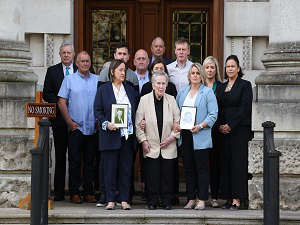
By Michael McHugh
Three similar incidents have happened on a pier where a car plunged into the sea and killed five people in Ireland, a rescue worker said.
John O'Raw, a crew member from the RNLI, dived to the vehicle when it was submerged around three metres underwater in Buncrana, Co Donegal, in March last year.
He was unable to open the doors and a smashed but intact driver's window presented a hazard which prevented him from entering the car.
Evan McGrotty, eight, his father Sean, 12-year-old brother Mark, grandmother Ruth Daniels, 59, and her 14-year-old daughter Jodie Lee Daniels died when their SUV sank after sliding off a "slippery as ice" slipway.
Mr O'Raw told an inquest: "I am aware of other incidents that have occurred there. I am personally aware probably of three incidents over a 17-year career."
He reached the car around 40 minutes after the first emergency response.
Mr O Raw said a window on the driver's side had been broken but was intact and bowed inwards, creating an obstacle to him entering the Audi to check for casualties in the back seats.
He said: "I did not understand what I saw at the time."
He agreed the window may have been bent when the driver Sean McGrotty sat on it during the last moments before the car sank. Other evidence has shown Mr McGrotty broke the window in a bid to help his family escape.
A bid by a rescuer to save one of the victims failed when he "got stuck" on something, separate evidence before this week's inquest in Buncrana showed.
The only survivor from the Londonderry family was a baby girl.
Former footballer Davitt Walsh swam out into the harbour in an effort to save the six occupants of the Audi Q7 and rescued the girl.
Mr McGrotty handed his four-month-old daughter Rionaghac-Ann to Mr Walsh through the driver's side window moments before the vehicle sank.
Mr Walsh tried to save another child, but said he seemed to "get stuck" on something.
 ABOVE: Davitt Walshe
ABOVE: Davitt Walshe
The vehicle was found during a technical examination to have been in serviceable condition before the accident.
The 2006 vehicle had laminated windows and technical expert Garda Damien Mulkearns said that affected how glass behaved after it was shattered.
It will take the same force to break as unlaminated glass but normal panes will shatter into a thousand pieces rather than staying together, the witness said.
The garda said when it had been treated it would turn "into a sheet of smashed glass" but may be held together by the lamination.
The driver's window was only a third down.
Garda Mulkearns agreed it would remain supported by the window rims.
He said: "It would certainly take added effort to remove it."
He could not say at what point the car's electronics failed.
He said the vehicle weighed about 3,200 kg.
A technical expert representing Audi, Gerard Boyle, said when the control unit became wet it would have shut down and the door would have been left in its original condition, locked or unlocked.
Other evidence suggested the car must have been locked at the time of the accident since rescuers were not able to get the door open, the inquest was told.
Doors can be set to lock when the car is driven, as an anti-theft measure.
Audi asserted in a report that electronics should work for several minutes in water.

Mr Boyle said the firm did not ask to examine the car after the accident and could not comment on how its doors behaved during the incident. Testing in water only began on later models.
He said if the door handle was used from the inside it should have opened.
"That is how the door should work."
He was unable to comment on the vehicle in question.
Audi's report said: "The panic of occupants of the vehicle must also be taken into consideration."
Mr Boyle said once the 4x4 lost friction with the slipway it would behave uncontrollably.
Handbrakes, footbrakes, gearing would not have made any difference, he said, adding: "The vehicle can only work within its capabilities."


 Woman escapes injury following arson attack in Derry/Londonderry
Woman escapes injury following arson attack in Derry/Londonderry
 Motorcyclist in critical condition following collision with van
Motorcyclist in critical condition following collision with van
 Court of Appeal affirms ruling on public inquiry in Sean Brown case
Court of Appeal affirms ruling on public inquiry in Sean Brown case
 Victims urge boycott of new Troubles legacy body during protest at its office
Victims urge boycott of new Troubles legacy body during protest at its office
 Kneecap investigated by counter terrorism officers over ‘kill your MP’ video
Kneecap investigated by counter terrorism officers over ‘kill your MP’ video